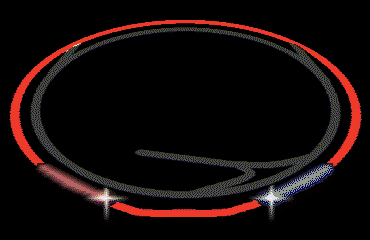
The storage ring uses the same guide field principle as the synchrotron--that is, particles travel in a circular orbit in vacuum under the influence of a magnetic field. Each electron or positron spends less than one-hundredth of a second in the synchrotron, but once it is transferred to the storage ring it must coast there for several hours. This puts very strict demands on the precision of the ring of magnets and on the quality of the vacuum. The residual air in the path of the beam particles must be many billion times less dense than in the normal atmosphere. The vacuum chamber and all interconnections are made entirely of metal which can be heated up to 150 degrees Celsius to drive any trapped gas out. The vacuum pumps distributed continuously around the ring use glow discharge to drive the air molecules into metal electrodes.
The particles coasting around the storage ring radiate a beam of X-rays like a headlight on a train. The power level of this "synchrotron radiation" is about half a megawatt. It strikes the vacuum chamber in a narrow stripe, depositing energy on the vacuum chamber wall. The heat generated must be carried away by water circulating through a channel in the vacuum chamber wall. The lost energy is restored to the circulating beam by radio-frequency (RF) cavities similar to those in the synchrotron and linac, although the beam is not actually accelerated. The RF system operates at a frequency of 500 million cycles per second (MHz) and is powered by a system rather like a television transmitter.

In the picture above, the storage ring is on the left side; sextuple (yellow) and quadropole (blue) focusing magnets can be seen in the foreground, with solenoidal bending magnets behind. Part of the synchrotron is visible on the right, and the bending of the tunnel is easily seen.